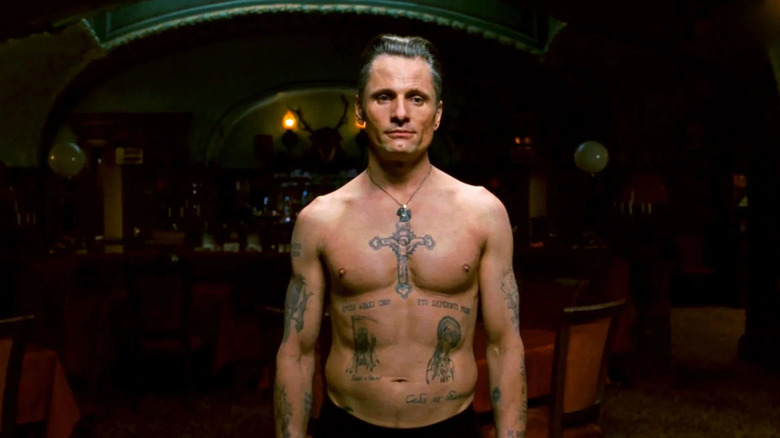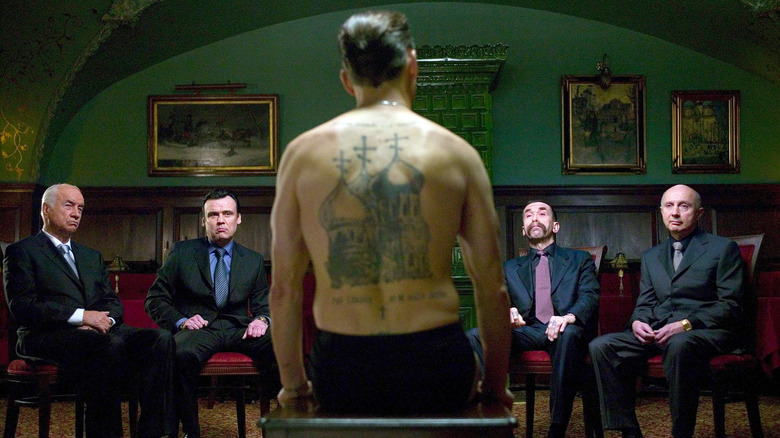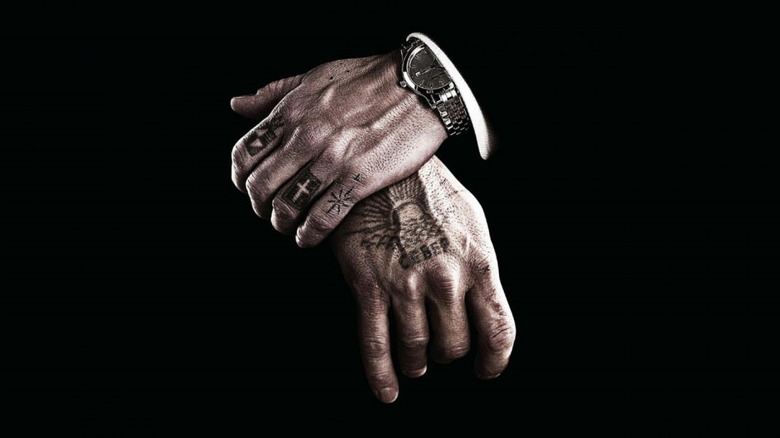Viggo Mortensen's Eastern Promises Tattoos Took Some Serious Research
David Cronenberg's 2007 crime drama "Eastern Promises" offers several memorable scenes — the one that often comes up in conversation is that bath house fight to the death featuring Mortensen's Nikolai as vulnerable as a man can be (and he fared a lot better than most of us would in the same situation). But another sequence leans just as far into the Canadian director's obsession with the language and evolution of the body.
Nikolai, a "fixer" for the London arm of the Russian mafia, is rising up in the ranks. Before he can go further, he must be evaluated; such assessments are done with the prospect presenting his body to high-ranking members so they can read the resume marked upon it. The tattoos etched into his skin say, for starters, that Nikolai had served time in a Siberian prison, and that he was formerly a thief — it's written all over him. The film's star has since revealed that it took considerable research to get the aesthetic, and that scene itself.
Speaking to Cinema Daily, Mortensen dove into the criminal ink and its real-life influences, first with Alix Lambert's award-winning 2001 documentary "The Mark of Cain" in which she gains access to an array of notorious Russian prisons and interviews inmates on their body art, which found its way to Cronenberg. Mortensen said:
"You know, your tattoos spoke about what crimes you'd committed, how many sentences you served. For example, the tattoos on my back in the movie that have the church, how many towers, each represent a prison term for example; some tattoos say whether you are in for murder, for robbing and rape, anything. They tell your story. And so that wasn't really in the script to begin with. And I showed this movie to David, and David got to know Alix a bit."
Maybe he's born with it, maybe it's illustrator's inks
Mortensen goes on to name-drop one of the most comprehensive collections of Russian prison tattoos, which served as further inspiration for Nikolai's look which he classifies as "kind of a passport."
"[T]here's also some books. That you may have seen, or some of your viewers may have seen 'Russian Criminal Tattoo.' There's two, three volumes. And those have a lot of those tattoos, and we took some of those and some other ones that I found, and that's where we ended up covering my body with. Stephen Knight then wrote a scene where I'm being interrogated. I have to pass a test in front of the mobsters and they look at the tattoos and read me, read my body and question me about it. Question my loyalty, they want to see if I'm authentic or if I'm not ready, you know, which could be the end of my life."
The scene in question can be seen here:
Mortensen, who refers to the scene as an "interview with the vampires," endured hours in the makeup trailer each day with Oscar-winning makeup designer Stephen Dupuis (who won for Cronenberg's "The Fly" in 1986) and the makeup fx team. There, they would apply transfers of the tattoos (with a damp washcloth, like the temporary tattoos you got as a kid) and touch them up with various methods including illustrator's inks. Dupuis would then top it all off with a spritz of flesh-colored makeup to age the overall look as if Nikolai had carried the markings for decades.
You went through the crosses in St. Petersburg?
Indeed, the "Russian Criminal Tattoo Encyclopedia" Mortensen mentions affirms the importance of tattoo code among the vor v zakone, wherein an unearned tattoo is as good as lying on your resume.
Alexei Plutser-Sarno's introduction in the encyclopedia's first volume lays the groundwork for the complex encoding involved in tattoo art among prisons like The Crosses in St. Petersburg, which is referenced in the aforementioned "Eastern Promises" scene: a St. Petersburg cross symbol on Nikolai's left ring finger indicates time served at the infamous institution. These marks are all what Plutser-Sarno categorizes as "socio-political communication" and elaborates in Volume I:
"In effect, these tattoos embody a thief's complete 'service record,' his entire biography. They detail all of his achievements and failures, his promotions and demotions, his 'secondments' to jail and his 'transfers' to different types of 'work.' A thief's tattoos are his passport, case file, awards record, diplomas, and epitaphs. In other words, his full set of official bureaucratic documents. Therefore, in the world of thieves a man with no tattoos has no social status whatsoever."
In this world, and the world of "Eastern Promises," tattoos represent a distinct, easily interpretable identity to the larger community of thieves, a world that dovetails with those Cronenberg travels to so often — where the body always exposes the truth.
The latest Cronenberg offering continues in this fashion, though the body modifications are far more intense. "Crimes of the Future," released earlier this year, reunites the "Scanners" director with Mortensen, who stars as a performance artist undergoing surgeries for audiences in an evolving world of changing bodies. Having seen the film and what his character goes through, it's hard to imagine what sort of research he could have done for this one.


